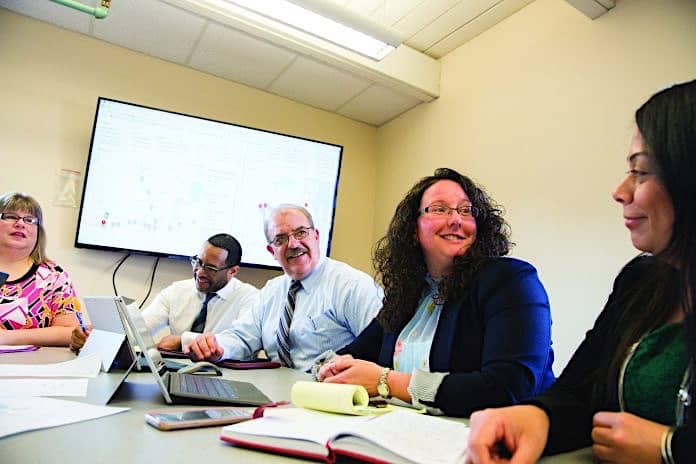When it comes to squeezing transportation departments for every last drop of monetary savings, optimized school bus routing is top of mind. Districts everywhere have turned, or are turning, to a host of software solutions that, in partnership with GPS, allow school bus operators to uncover routing efficiencies and to better map routes to bell times, even adjusting the latter as necessary. The list of potential solutions goes on and on.
The goal is for school districts to reduce operational costs, funneling more money to classrooms. The same goes for a state with an area similar to that of many counties across the nation, but with every ounce of the same operational and cost challenges.
Rhode Island is about the size of Fairfax County, Virginia but at the same time boasts the second-highest state population density behind New Jersey. In fact, the Ocean State crams about the same number of people per square mile as do Fairfax County and Montgomery County, Maryland, both growing Washington, D.C. suburbs.
Rhode Island’s three-dozen public school districts also have similar budget holes to climb out of despite little if any new state funds. Making Rhode Island more unique are the many land jetties and bodies of water school bus operators must contend with. And up until about seven or eight years ago, each school district provided its own transportation service, or oversaw a hodgepodge of contractors.
“In many cases that would mean a bus leaving multiple school districts with small numbers of students going to the same placement school outside of the district,” explained Cynthia Brown, director of the office of statewide efficiencies at the Rhode Island Department of Elementary and Secondary Education. “Under this method, each school district was responsible for the full cost of these buses.”
In short, school bus routes were needlessly crisscrossing each other. Deadhead routes were out of control and with them went costs and efficiencies. Student ride times, especially those for students with disabilities, were far too lengthy.
In 2007, the department of education, or simply RIDE, issued an RFP as it sought a transportation consultant to step in and provide a feasibility study for implementing solutions. At about the same time, the state assembly passed legislation to create a statewide transportation system for out-of-district special education and nonpublic school students, whose routes were at the heart of the problem. Furthering the need to quell runaway school bus costs was the fact that state transportation funding for local districts dried up.
“The districts look to the state not only for direct education aid, but also for statewide solutions to issues not easily handled on a district-by-district basis,” said Brown. “A top priority was a single statewide, efficient and well-run transportation system for special education, non-public, career and technical, charter school and other students who go out of their resident community to other schools for their educational program.”
Management Partnership Services, Inc. (MPS) won the contract in December 2007 and shortly thereafter put together a logistics plan, said Andy Forsyth, formerly the company’s co-founder and vice president. MPS helped RIDE identify a subset of all out-of-district special education routes and restricted them to only 12 districts, following Brown’s request to keep the project within a limited scope, at first.
Following the study’s conclusion, RIDE put out a bid for a third-party system manager. Transpar Group came on board after winning the contract. By 2012, Transpar acquired MPS.
In the meantime, Transpar created a baseline aggregate cost of school districts providing their own transportation, limited it to just 12 schools to meet RIDE’s requirement to start small and compared it with a school bus contractor-provided model.
The result was a potential 8- to 12-percent cost-benefit from outsourcing. And the students also stood to benefit from reduced deadhead miles and ride times.
“A greater matrix of logistical options cut, in some instances, ride times in half,” added Forsyth, who is now vice president of Transpar. “It was a win-win situation.”
Teamwork Equates to Big Savings
Still, the project was going to be extremely challenging despite Rhode Island’s limited geographic size and a relatively small number of students. The state’s inlets and natural barriers prohibit bus ride distances as the crow flies. There are no straight lines from here to there but plenty of twists and turns, according to Forsyth.
“You can’t drive across Narragansett Bay, obviously,” he added.
Transpar started with special education students, who by very nature can be placed into different schools depending upon their specific needs, Forsyth explained. Therefore, routes that serve this student population must be “very malleable because they’re ever-changing,” he added. Next, private schools were phased in.
Today, Transpar oversees the transportation of more than 2,600 students—about 1,300 of which are non-public or private school students, another 750 being students with disabilities and most of the others attending career and technical schools—and the school bus operations of contractors First Student and Ocean State Transit, a subsidiary of Student Transportation of America.
The program is “small in terms of numbers but still it’s a very costly form of transportation,” Forsyth said. “It requires a tremendous amount of attention.”
Though First Student and Ocean State Transit provide the buses, drivers and maintenance, Transpar Group creates, reviews and manages all routes for the contractors that are operated daily out of 13 locations. It also oversees a new albeit small fleet of allowable vans and SUVs for student transport.
“We provide routing services for the statewide program to ensure that student needs are met related to reasonable run times, on-time drop-off and pick-up and that routes are operating as efficiently as possible in accordance with RIDE’s guidelines,” explained Nicole Martin, Transpar’s manager for the statewide program.
She and her team also oversee vendor contract compliance and coordinates all student registration, routing and customer service.
RIDE’s Brown said she appreciates the checks and balances, which directly keep costs down as students are transported to 187 different school campuses across Rhode Island, and even a few in Massachusetts.
“By doing so, the vendor providing the buses is not determining how many buses are needed, which is the situation when a vendor creates the route,” she added.
The Contractor Performance Management Program, or CPMP, is unique to Rhode Island’s statewide program. Both Brown and Forsyth said it is nonpunitive in nature, instead fostering a supportive partnership between Transpar, RIDE and the school bus contractors, while also ensuring all four remain accountable to each other.
Brown explained that a technical performance assessment is also compiled annually to gauge monthly performance, trends and a statistical summary of key financial and operational data. Data analysis suggests what potential or actual problem areas are and offers summary conclusions on what areas the team needs to focus on for the upcoming year.
“What we’ve engineered is a very ambitious program for contractors to ensure they comply with terms, but we also measure how effectively and efficiently we manage the operation,” added Forsyth.
By all accounts, the program is a success and then some. Brown said the first three years of the program resulted in $7.3 million in savings statewide. That figure jumped to $12 million through the end of the 2015 fiscal year. The current overall cost of the program is budgeted at $23 million, of which the state contributes $3.2 million toward the cost of non-public school transportation provided under the statewide program.
“These savings directly benefit the taxpayers of our communities and allow funds to be redirected toward educational improvements,” she added.
Editor’s Note: Reprinted from the April 2017 issue of School Transportation News magazine.

















